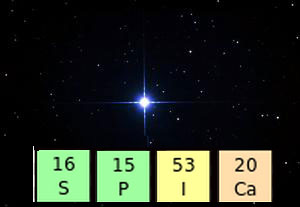 , or if you recall the actress who played the part of a sultry James Bond villain,
, or if you recall the actress who played the part of a sultry James Bond villain, , or if we stick to chemistry
, or if we stick to chemistry  . In the English language alone, there are also thousands of improper nouns with such properties (27192, to be exact), and of course someone wrote a program to generate an exhaustive list. Probably one of the most interesting ones is CHOPS, as in pork chops, because the elements are all actually found in meat and include five of the six most common elements in living matter.
. In the English language alone, there are also thousands of improper nouns with such properties (27192, to be exact), and of course someone wrote a program to generate an exhaustive list. Probably one of the most interesting ones is CHOPS, as in pork chops, because the elements are all actually found in meat and include five of the six most common elements in living matter.Unfortunately, it's a hopeless case for any chemical compound's name ending in ide, but luckily there is CoPPEr CArBONaTe, a substance formerly believed to make up Lady Liberty's veneer. It's ironic that more names, relative to inorganic nomenclature, exist for the elements themselves (IrON, CArBON, TiN, NeON, KrYPtON, SiLiCoN, CoPPEr, ArSeNIC, SiLvEr and four others). Silver's inclusion depends on the synthetic superheavy element Lv, or livermorium, a name only officially adopted last year after the element was synthesized in 2000 from uniting calcium and curium nuclei. Livermorium is not honoring dead liver but named after the Lawrence Livermore National Laboratory.
In organic chemistry, it should be easy to find names fitting the criteria, given the field's gargantuan vocabulary. Although there are none among the basic heterocyclics; only AlKYNe among the basic functional groups and the lone VAlINe among the 20 amino acids, there is a sweet spot among alkanes: PrOPaNe, BUTaNe, NoNaNe and gasoline's HePTaNe and OCTaNe. And turning to astronomy, order in the universe is further restored due to the existence of the MoON, SUN, SAtURn, NePtUNe, URaNUS, at least one asteroid, CeReS, at least a couple of constellations, BOOTeS and CaPrICORnUS, and some of the brightest stars,
 SIrIUS, AlTaIr and SPICa.
SIrIUS, AlTaIr and SPICa. Spica's name contains two of the alpha ladder elements (Ca and S) produced during helium fusion. The remaining pair, phosphorus and iodine, are formed mostly in type II supernovae, and being a blue giant with 10 solar masses, Spica is a candidate for such a fate.
* This article was coauthored and edited by PINa TeOLi. No wonder I married her.